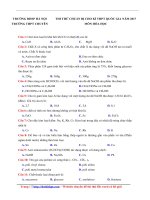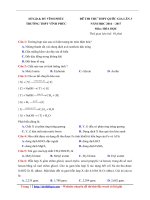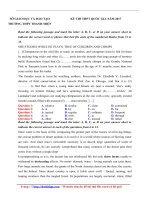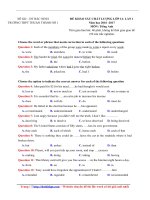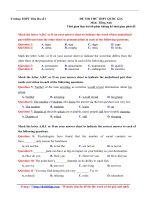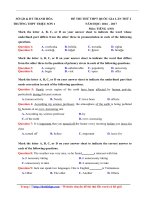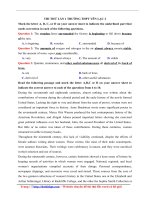- Trang chủ >>
- THPT Quốc Gia >>
- Ngoại Ngữ
thpt quang xuong 1 mon tieng anh lan 1 nam 2017 file word co loi giai
Bạn đang xem bản rút gọn của tài liệu. Xem và tải ngay bản đầy đủ của tài liệu tại đây (129.29 KB, 16 trang )
SỞ GIÁO DỤC VÀ ĐÀO
TẠO
TRƯỜNG THPT QX 1
(Đề thi có 07 trang)
ĐỀ THI THỬ THPT QUỐC GIA LẦN 1
NĂM HỌC 2016 - 2017
Môn thi: Tiếng Anh
Thời gian làm bài: 60 phút, không kể thời gian phát đề
Mã đề 345
Mark the letter A, B, C, or D on your answer sheet to indicate the underlined part that
needs correction in each of the following questions.
1. The wooden fence surrounded the factory is beginning to fall down because of the rain.
A. is beginning
B. wooden
C. surrounded
D. because of
2. The amounts of oxygen and nitrogen in the air almost always remain stable, but the amount
of water vapor vary considerably.
A. vary
B. almost always
C. The amount of
D. stable
3. Quinine, cinnamon, and other useful substances are all derived of the bark of trees.
A. are
B. bark of trees
C. derived of
D. other useful substances
Read the following passage and mark the letter A,B, C or D on your answer sheet to
indicate the correct answer to each of the questions from 4 to 10.
During the seventeenth and eighteenth centuries, almost nothing was written about the
contributions of women during the colonial period and the early history of the newly formed
United States. Lacking the right to vote and absent from the seats of power, women were not
considered an important force in history. Anne Bradstreet wrote some significant poetry in the
seventeenth century, Mercy Otis Warren produced the best contemporary history of the
American Revolution, and Abigail Adams penned important letters showing she exercised
great political influence over her husband, John, the second President of the United States.
But little or no notice was taken of these contributions. During these centuries, women
remained invisible in history books.
Throughout the nineteenth century, this lack of visibility continued, despite the efforts of
female authors writing about women. These writers, like most of their male counterparts,
were amateur historians. Their writings were celebratory in nature, and they were uncritical in
their selection and use of sources.
During the nineteenth century, however, certain feminists showed a keen sense of history
by keeping records of activities in which women were engaged. National, regional, and local
women's organizations compiled accounts of their doings. Personal correspondence,
newspaper clippings, and souvenirs were saved and stored. These sources from the core of the
two greatest collections of women's history in the United States one at the Elizabeth and
Arthur Schlesinger Library at Radcliffe College, and the other the Sophia Smith Collection at
Smith College. Such sources have provided valuable materials for later Generations of
historians.
Despite the gathering of more information about ordinary women during the nineteenth
Century, most of the writing about women conformed to the "great women" theory of History,
– Chuyên đề thi file word có lời giải chi tiết mới nhất
Trang 1
just as much of mainstream American history concentrated on "great men." To demonstrate
that women were making significant contributions to American life, female authors singled
out women leaders and wrote biographies, or else important women produced their
autobiographies. Most of these leaders were involved in public life as reformers, activists
working for women's right to vote, or authors, and were not representative at all of the great
of ordinary woman. The lives of ordinary people continued, generally, to be untold in the
American histories being published.
4. In the last paragraph, the author mentions all of the following as possible roles of
nineteenth- century "great women" EXCEPT ________.
A. reformers
B. politicians
C. activists for women's rights
D. authors
5. The word "they" in the 2nd paragraph refers to ________.
A. sources
B. efforts
C. authors
D. counterparts
6. In the first paragraph, Bradstreet, Warren, and Adams are mentioned to show that
________.
A. even the contributions of outstanding women were ignored
B. poetry produced by women was more readily accepted than other writing by women
C. only three women were able to get their writing published
D. a woman's status was changed by marriage
7. The word "representative" in the last paragraph is closest in meaning to________.
A. satisfied
B. typical
C. distinctive
D. supportive
8. In the 2 paragraph, what weakness in nineteenth-century histories does the author point
out?
A. The sources of the information they were based on were not necessarily accurate.
B. They were printed on poor-quality paper.
C. They left out discussion of the influence of money on politics.
D. They put too much emphasis on daily activities.
9. What use was made of the nineteenth-century women's history materials in the Schlesinger
Library and the Sophia Smith Collection?
A. They provided valuable information for twentieth- century historical researchers.
B. They formed the basis of college courses in the nineteenth century.
C. They were shared among women's colleges throughout the United States.
D. They were combined and published in a multi volume encyclopedia.
10. What does the passage mainly discuss?
A. The place of American women in written histories
B. The "great women" approach to history used by American historians
C. The keen sense of history shown by American women
D. The role of literature in early American histories
Mark the letter A, B, C, or D on your answer sheet to indicate the sentence that is closest in
meaning to each of the following questions.
– Chuyên đề thi file word có lời giải chi tiết mới nhất
Trang 2
11. I would rather you wore something more formal to work.
A. I'd prefer you wearing something more formal to work.
B. I'd prefer you to wear something more formal to work.
C. I'd prefer you should wear something more formal to work.
D. I'd prefer you wear something more formal to work.
12. Had we left any later, we would have missed the train.
A. We didn't miss the train because it left late.
B. We left too late to catch the train.
C. Because the train was late, we missed it.
D. We almost missed the train.
13. "Why can't you do your work more carefully? " said Henry's boss.
A. Henry's boss criticized him for doing his job carelessly.
B. Henry's boss asked him not to do his job with care.
C. Henry's boss suggested doing the job more carefully.
D. Henry's boss warned him to do the job carefully.
Mark the letter A, B, C, or D on your answer sheet to indicate the word whose underlined
part differs from the other three in pronunciation in each of the following questions.
14. A. lives
B. plays
C. works
D. buys
15. A. picked
B. worked
C. naked
D. booked
Mark the letter A, B, C, or D on your answer sheet to indicate the sentence that best
combines each pair of sentences in the following questions.
16. He felt tired. However, he was determined to continue to climb up the mountain.
A. Tired as he might feel, he was determined to continue to climb up the mountain
B. He felt so tired that he was determined to continue to climb up the mountain.
C. Feeling very tired, he was determined to continue to climb up the mountain.
D. As a result of his tiredness, he was determined to continue to climb up the mountain.
17. The agreement ended six-month negotiation. It was signed yesterday.
A. The agreement which ends six-month negotiation was signed yesterday.
B. The negotiation which lasted six months was signed yesterday.
C. The agreement which was signed yesterday lasted six months.
D. The agreement which was signed yesterday ended six-month negotiation.
Mark the letter A, B, C or D on your answer sheet to indicate the word that differs from the
other three in the position of the primary stress in each of the following questions.
18. A. cosmetics
B. fertility
C. experience
D. economics
19. A. informality
B. appropriate
C. situation
D. entertainment
Read the following passage and mark the letter A, B, C or D on your answer sheet to
indicate the correct answer to each of the questions from 20 to 27.
It is commonly believed that school is where people go to get an education. Nevertheless,
it has been said that today children interrupt their education to go to school. The difference
between schooling and education implied by this remark is important.
– Chuyên đề thi file word có lời giải chi tiết mới nhất
Trang 3
Education is much more open-ended and all-inclusive than schooling. Education knows
no limits. It can take place anywhere, whether in the shower or on the job, whether in the
kitchen or on a tractor. It includes both the formal learning that takes place in school and the
whole universe of informal learning. The agent (doer) of education can vary from respected
grandparents to the people arguing about politics on the radio, from a child to a famous
scientist. Whereas schooling has a certain predictability, education quite often produces
surprises. A chance conversation with a stranger may lead a person to discover how little is
known of other religions. People receive education from infancy on. Education, then, is a very
broad, inclusive term; it is a lifelong process, a process that starts long before the start of
school, and one that should be a necessary part of one’s entire life.
Schooling, on the other hand, is a specific, formalized process, whose general pattern
varies little from one setting to the next. Throughout a country, children arrive at school at
about the same time, take the assigned seats, are taught by an adult, use similar textbooks, do
homework, take exams, and so on. The pieces of reality that are to be learned, whether they
are the alphabet or an understanding of the workings of governments, have been limited by
the subjects being taught. For example, high school students know that they are not likely to
find out in their classes the truth about political problems in their society or what the newest
filmmakers are experimenting with. There are clear and undoubted conditions surrounding the
formalized process of schooling.
20. In the passage, the expression "children interrupt their education to go to school" mostly
implies that________.
A. schooling prevents people discovering things
B. schooling takes place everywhere
C. all of life is an education
D. education is totally ruined by schooling
21. What does the writer mean by saying ''education quite often produces surprises"?
A. Educators often produce surprises.
B. Informal learning often brings about unexpected results.
C. Success of informal learning is predictable.
D. It's surprising that we know little about other religions.
22. Which of the following would the writer support?
A. Without formal education, people won't be able to read and write.
B. Going to school is only part of how people become educated.
C. Schooling is of no use because students do similar things everyday.
D. Our education system needs to be changed as soon as possible.
23. According to the passage, the doers of education are ________.
A. only respected grandparents
B. mostly famous scientists
C. mainly politicians
D. almost all people
24. Which of the following is TRUE according to the passage?
A. Education and schooling are quite different experience.
– Chuyên đề thi file word có lời giải chi tiết mới nhất
Trang 4
B. The more years students go to school, the better their educationis.
C. Students benefit from schools, which require long hours and homework.
D. The best schools teach a variety of subjects.
25. The word "they" in the last paragraph refers to ________.
A. workings of governments
B. newest film makers
C. political problems
D. high school students
26. The word "all-inclusive" in the passage mostly means ________.
A. including everything or everyone
B. going in many directions
C. involving many school subjects
D. allowing no exceptions
27. This passage is mainly aimed at ________.
A. telling the difference between the meanings of two related words "schooling" and
"education"
B. telling a story about excellent teachers
C. listing and discussing several educational problems
D. giving examples of different schools
Mark the letter A, B, C or D on your answer sheet to indicate the word(s) CLOSEST in
meaning to the underlined word(s) in each of the following questions.
28. When I mentioned the party, he was all ears.
A. using both ears
B. listening neglectfully
C. listening attentively
D. partially deaf
29. John wants to buy a new car, so he starts setting aside a small part of his monthly
earnings.
A. spending on
B. putting out
C. using up
D. saving up
Read the following passage and mark the letter A, B, C or D on your answer sheet to
indicate the correct word or phrase that best fits each of the numbered blanks from 30 to
34.
HOW TO AVOID MISCOMMUNICATION IN THE WORKPLACE
As a small-business owner, you can avoid many problems simply by improving
communication in your office.
By clarifying everyone’s expectations and roles, you'll help to (30) ________ greater
trust and increased productivity among employees. Here are a few tips for doing so.
Practice active listening. The art of active listening includes (31) ________ close
attention to what another person is saying, then paraphrasing what you've heard and repeating
it back. Concentrate (32) ________ the conversation at hand and avoid unwanted
interruptions (cellphone calls, others walking into your office, etc.). Take note of how your
own experience and values may color your perception.
Pay attention to non-verbal cues. We don't communicate with words alone. Every
conversation comes with a host of non-verbal cues - facial expressions, body language, etc. that may (33) ________ contradict what we’re saying. Before addressing a staff member or
(34)
– Chuyên đề thi file word có lời giải chi tiết mới nhất
Trang 5
________ a project conference, think carefully about your tone of voice, how you make eye
contact, and what your body is "saying." Be consistent throughout.
Be clear and to the point. Don't cloud instructions or requests with irrelevant details, such
as problems with past projects or issues with long-departed personnel. State what you need
and what you expect. Ask, "Does anyone have any questions?"
Demonstrate that you
prefer questions up-front as opposed to misinterpretation later on.
30. A. set up
B. establish
C. create
D. build
31. A. showing
B. paying
C. using
D. spending
32. A. for
B. to
C. on
D. in
33. A. intentional
B. unintentional
C. intentionally
D. unintentionally
34. A. to lead
B. being led
C. leading
D. lead
Mark the letter A, B, C, or D on your answer sheet to indicate the correct answer to each of
the following questions.
35. He was offered the job thanks to his ________ performance during his job interview.
A. impressive
B. impressively
C. compression
D. impress
36. Someone who is ________ is hopeful about the future or the success of something in
particular.
A. pessimist
B. optimistic
C. optimist
D. pessimistic
37. The preparations ________ by the time the guests ________ .
A. have finished/arrived
B. have been finished /arrived
C. had been finished/ arrived
D. had finished /arrived
38. Asian ________, Mr. Pike is very worried about the increasing of teenager crimes.
A. educational
B. education
C. educator
D. educate
39. ________ turned out to be true.
A. Everything she had told us which
B. Everything where she had told us
C. Everything she had told us
D. That everything she told us
40. You'd better get someone ________ your living room.
A. redecorated
B. to redecorate
C. redecorating.
D. redecorate
41. Can you take ________ of the shop while Mr. Green is away?
A. operation
B. charge
C. management
D. running
42. They held a party to congratulate their son ________ his success to become an engineer.
A. in
B. on
C. with
D. for
43. They always kept on good ________ with their next-door neighbors for the children's
sake.
A. terms
B. relations
C. will
D. relationship
44. They had invited over one hundred guests, ________.
A. not any of whom I knew
B. I did not know any of whom
C. I knew none of who
D. none of whom I knew
45. Please ________ and see us when you have time. You are always welcome.
A. come away
B. come to
C. come in
D. come round
– Chuyên đề thi file word có lời giải chi tiết mới nhất
Trang 6
46. Not only ________ to determine the depth of the ocean floor, but it is also used to locate
oil.
A. seismology is used B. is seismology used
C. using seismology
D. to use seismology
Mark the letter A, B, C, or D on your answer sheet to indicate the most suitable response to
complete each of the following exchanges.
47. "What a great haircut, Lucy!"________-"________"
A. It's my pleasure.
B. Oh, yes. That's right.
C. Thanks. It's very kind of you to do this
D. Thank you. That's a nice compliment.
48. "A motorbike knocked Ted down". -"________"
A. How terrific!
B. Poor him!
C. What is it now? D. What a motorbike!
Mark the letter A, B, C or D on your answer sheet to indicate the word(s) OPPOSITE in
meaning to the underlined word(s) in each of the following questions.
49. A trial must be fair and impartial.
A. apprehensive
B. hostile
C. biased
D. unprejudiced
50. After her husband's tragic accident, she took up his position at the university.
A. incredible
B. boring
C. mysterious
D. comic
--------- THE END ---------
– Chuyên đề thi file word có lời giải chi tiết mới nhất
Trang 7
HƯỚNG DẪN GIẢI CHI TIẾT
Thực hiện: Ban Chuyên môn Tuyensinh247.com
1. C
11. B
21. B
31. B
41. B
2. A
12. D
22. B
32. C
42. B
3. C
13. A
23. D
33. D
43. A
4. B
14. C
24. A
34. C
44. D
5. C
15. C
25. D
35. A
45. D
6. A
16. A
26. A
36. B
46. B
7. B
17. D
27. A
37. C
47. D
8. A
18. D
28. C
38. C
48. B
9. A
19. B
29. D
39. C
49. C
10. A
20. C
30. D
40. B
50. D
1. C
Surrounded => surrounding
Chủ điểm ngữ pháp: mệnh đề quan hệ
Rút gọn mệnh đề quan hệ dạng chủ động: bỏ chủ ngữ sau đó V→ v_ing
The wooden fence [which surrounds]/ surrounding the factory is beginning to fall down
because of the rain.
2. A
Vary=> varies
The amount of +N(it)+ V(it): luợng lớn...
The amounts of +N (nhiều)+ V (nhiều): luợng lớn
Nên trong câu này chủ ngữ ở mệnh đề sau là chủ ngữ số ít-> động từ thêm “s/es”.
3. C
derived of => derived from
Chủ điểm ngữ pháp: collocation
Derive from sth: chiết suất từ, nguồn gốc từ.
4. B
Trong đoạn văn cuối, tác giả đề cập các vai trò phụ nữ có thể đảm nhận trong thế kỷ muời
chín NGOẠI TRỪ.
A. Reformers: nhà cải cách
B. Politicians: chính khách
C. Activists for women's rights: nhà hoạt động vì quyền phụ nữ
D. Authors: tác giả
Dẫn chứng: Most of these leaders were involved in public life as reformers, activists
working for women's right to vote, or authors.
5. C
Từ “they” trong đoạn 2 nói đến
A. Sources: các nguồn tư liệu
B. Efforts: những sự cố gắng
C. Authors: các tác giả
D. Counterparts: những nguời đồng nhiệm
Dẫn chứng: These writers, like most of their male counterparts, were amateur historians.
Their writings were celebratory in nature, and they were uncritical in their selection and use of
sources. (Những nhà văn này, giống nhu hầu hết những nguời đồng nhiệm nam, là những nhà
sử học nghiệp dư. Các tác phẩm của họ đuợc ca tụng một cách vô tư, và họ đã không đắn đo
về sự lựa chọn và sử dụng nguồn tư liệu của mình.)
6. A
– Chuyên đề thi file word có lời giải chi tiết mới nhất
Trang 8
Trong đoạn văn đầu tiên, Bradstreet, Warren, and Adams đuợc đề cập để chỉ ra rằng
A. Thậm chí những đóng góp của những phụ nữ suất chúng cũng bị phớt lờ.
B. Những bài thơ đuợc viết bởi phụ nữ thì dễ được đón nhận hơn các thể loại tác phẩm
khác của họ.
C. Chỉ có 3 phụ nữ từng cố gắng để tác phẩm của họ được xuất bản.
D. Một hình tượng người phụ nữ bị thay đổi bởi việc kết hôn.
Dẫn chứng: Anne Bradstreet wrote some significant poetry in the seventeenth century,
Mercy Otis Warren produced the best contemporary history of the American Revolution, and
Abigail Adams penned important letters showing she exercised great political influence over
her husband, John, the second President of the United States. But little or no notice was taken
of these contributions. => những người phụ nữ này đã có những đóng góp to lón nhưng vẫn bị
bỏ qua.
7. B
Từ “representative” trong đoạn văn cuối gần nghĩa nhất với
A. satisfied: hài lòng
B. typical: điển hình
C. distinctive: đặc biệt
D. supportive: giúp đỡ
representative: tiêu biểu
8. A
Đâu là điểm yếu của lịch sử thế kỷ 19 được tác giả chỉ ra?
A. Nguồn thông tin họ dựa vào không thật sự chính xác.
B. Họ đã in trên giấy chất lượng thấp.
C. Họ đã bỏ qua sự ảnh hưởng của tiền lên chính trị.
D. Họ đặt quá nhiều nhấn mạnh vào đời sống thường ngày.
Dẫn chứng: Their writings were celebratory in nature, and they were uncritical in their
selection and use of sources. (Các tác phẩm của họ được ca tụng một cách vô tư, và họ đã
không đắn đo về sự lựa chọn và sử dụng nguồn tư liệu của mình.)
9. A
Tư liệu lịch sử về phụ nữ thế kỷ 19 ở thư viện Schlesinger và bộ sưu tập Sophia Smith đã
được sử dụng để làm gì?
A. Chúng cung cấp thông tin giá trị cho những nhà nghiên cứu lịch sử thế kỷ 20.
B. Chúng trình bày những khóa học đại học cơ bản ở thế kỷ 19.
C. Chúng được chia sẻ giữa các trường đại học cho nữ ở khắp nước Mỹ.
D. Chúng được tổng hợp và công bố trong một bách khoa toàn thư nhiều tập.
Dẫn chứng: Such sources have provided valuable materials for later Generations of
historians. Những nguồn này đã cung cấp những tư liệu giá trị cho những thế hệ nghiên cứu
lịch sử sau.
10. A
Bài chủ yếu thảo luận về chủ đề gì?
A. Việc phụ nữ được viết trong lịch sử nước Mỹ.
B. “great woman” đi vào lịch sử bởi những nhà sử học Mỹ.
– Chuyên đề thi file word có lời giải chi tiết mới nhất
Trang 9
C. Sự quan tâm lịch sử sâu sắc được cho thấy bởi những người phụ nữ Mỹ.
D. Vai trò của văn học trọng lịch sử nước Mỹ thời kỳ đầu.
Dẫn chứng: During these centuries, women remained invisible in history books.... To
demonstrate that women were making significant contributions to American life.
11. B
Tôi muốn bạn mặc quần áo lịch sự hơn để đi làm.
Câu giả định trái với thực tế ở hiện tại:
S1+ would rather+ (that)+ S2+ V_ed = S1+ would prefer +S2+ to V.
12. D
Neu chúng tôi rời đi muộn hơn 1 chút nữa, chúng tôi đã nhỡ chuyến tàu rồi.
Câu điều kiện loại 3 dạng đảo ngữ: had+S+pp, S+would+ have+ pp.
A. Chúng tôi đã không nhỡ tàu vì nó rời đi muộn.
B. Chúng tôi đến quá muộn để bắt kịp chuyến tàu.
C. Bởi vì chuyến tàu đến muộn, chúng tôi đã lỡ nó.
D. Chúng tôi gần như đã nhỡ chuyến tàu.
13. A
“Cậu không thể làm việc cẩn thận hơn hay sao?” - sếp của Henry nói.
Criticize sb for sth= chỉ trích, phê phán ai về việc gì.
Suggest + V_ing: rủ ai cùng làm gì.
A. sếp của Henry phê bình anh ta vì làm việc một cách bất cẩn.
B. sếp của Henry yêu cầu anh ta không càn làm việc cẩn thận.
C. sếp của Henry gợi ý họ cùng làm việc một cách cẩn thận.
D. sếp của Henry cảnh báo anh ta phải làm việc một cách cẩn thận.
14. C
A. lives /laɪvz/
B. plays /pleɪz/
C. work /wɜːk/
D. buy /baɪ/
Cách phát âm đuôi “-s” và “-es”
• /s/: tận cùng là âm vô thanh [f,k,p,t,θ]
VD: chefs, kicks, claps, hits, paths /pɑːθs/
• /s/: tận cùng là [p,pe,f,fe,gh,ph,t,te,k,ke]
VD: claps, hopes, laughs/ la:fs/, photographs, hats, hates, kicks, lakes,...
• /iz/: tận cùng là [s, ʃ, tʃ, z, d3]
VD: buses, washes, catches, buzzes, judges,...
• /iz/: tận cùng là [s,x,ch,sh,ce,se,ge]
VD: classes, boxes, watches, voices, horses, pages,...
• /z/ tận cùng là các phụ âm còn lại - phụ âm hữu thanh [b, d, g,l, m, n, r, v, ð] sau các
nguyên âm VD: rubs, cards, eggs, walls, names, cleans, wears, lives, clothes, tries /traiz/,
toys / toiz/,...
15. C
A. picked /pɪkt/
B. worked /wɜːkt/
C. naked /ˈneɪkɪd/
D. booked /bʊkt/
– Chuyên đề thi file word có lời giải chi tiết mới nhất
Trang 10
Cách phát âm đuôi “ed”
• /t/: tận cùng là âm vô thanh [f,k,p,t,9, J,tJ ]
Ví dụ: watched, looked, stopped, worked, placed, passed,...
• /id/: tận cùng là [t,d], đặc biệt: động từ dạng v_ed được dùng nhu tính từ (wicked,
aged,...)
Ví dụ: needed, wanted, decided, waited, edited, ...
• /d/: tận cùng là âm hữu thanh gồm các phụ âm còn lại và nguyên âm.
Ví dụ: lived, played, studied, filled, cleaned, followed, called, prepared,...
16. A
Anh ay thấy rat mệt. Nhung anh ay đã quyết định tiếp tục leo lên đỉnh núi.
Chủ điểm ngữ pháp: cấu trúc câu nhấn mạnh với tính từ
However adj/adv + SV, SV = Adj as SV, SV: mặc dù.... đến thế nào nhưng...
A. Mặc dù anh ấy thấy rất mệt, anh ấy vẫn quyết định tiếp tục leo lên đỉnh núi.
B. Anh ấy thấy quá mệt nên anh ấy quyết định tiếp tục leo lên đỉnh núi.
C. Cảm thấy rất mệt, anh ấy quyết định tiếp tục leo lên đỉnh núi.
D. Như là kết quả của sự mệt mỏi, anh ấy quyết định tiếp tục leo lên đỉnh núi.
17. I)
Thỏa thuận đã kết thúc 6 tháng đàm phán. Nó đã được ký ngày hôm qua.
Chủ điểm ngữ pháp: mệnh đề quan hệ
Which làm chủ ngữ hoặc tân ngữ trong mệnh đề quan hệ, thay thế cho danh từ chỉ
vật ... .N (thing) + WHICH + V + o ... .N (thing) + WHICH + S + V
A. Bản hợp đồng cái kết thúc 6 tháng đàm phán đã được ký hôm qua.
B. Sự đàm phán cái đã kéo dài 6 tháng đã được ký ngày hôm qua.
C. Bản họp cái được ký ngày hôm qua đã kéo dài 6 tháng.
D. Bản hợp đồng cái được ký ngày hôm qua đã kết thúc 6 tháng đàm phán.
18. D
A. cosmetics /kɒzˈmetɪks/
B. fertility /fəˈtɪləti/
C. experience /ɪkˈspɪəriəns/
D. economics /ˌiːkəˈnɒmɪks/
Trọng âm chính rơi vào vào âm tiết đứng trước các hậu tố: ance, ence, ience, iar, ior, ics,
ic, ity, ory.
19. B
A. informality /ˌɪnfɔːˈmæləti/
B. appropriate /əˈprəʊpriət/
C. situation /ˌsɪtʃuˈeɪʃn/
D. entertainment /ˌentəˈteɪnmənt/
Trọng âm chính rơi vào vào âm tiết đứng trước các hậu tố: ion, ity, ance.
Trọng âm chính rơi vào vào âm tiết đứng thứ ba từ âm tiết cuối lên: ate.
Trọng âm chính rơi vào vào âm tiết: ain, ique, oo, aire.
20. C
Trong đoạn văn, cụm từ "children interrupt their education to go to school" ngụ ý rằng
A. Việc học chính quy ngăn cản con người khám phá cuộc sống.
B. Việc học chính quy diễn ra ở mọi nơi.
– Chuyên đề thi file word có lời giải chi tiết mới nhất
Trang 11
C. Cả cuộc sống là một sự giáo dục.
D. Giáo dục hoàn toàn bị phá hủy bởi việc học ở trường.
Dẫn chứng: Education, then, is a very broad, inclusive term; it is a lifelong process, a
process that starts long before the start of school, and one that should be a necessary part of
one’s entire life.
21. B
Hàm ý của tác giả là gì khi nói rang "education quite often produces surprises"?
A. Các nhà giáo dục học thường tạo ra những bất ngờ.
B. Việc học không chính quy thường mang đến những kết quả ngoài dự đoán.
C. Thành công của việc học không chính quy là có thể dự đoán.
D. Điều bất ngờ là chúng ta biết khá ít về tôn giáo khác.
Dẫn chứng: Whereas schooling has a certain predictability, education quite often
produces surprises. Trái với việc học ở trường có sự dự đoán chắc chắn, giáo dục thường tạo
ra nhiều điều bất ngờ.
22. B
Tác giả ủng hộ điều nào sau đây?
A. Không có giáo dục chính quy thì con người không thể biết đọc và viết.
B. Đến trường học chỉ là một phần trong cách con người trở thành có giáo dục.
C. Trường học không có tác dụng gì vì học sinh chỉ làm những điều giống nhau mỗi
ngày.
D. Hệ thống giáo dục của chúng ta cần phải được thay đổi càng sớm càng tốt.
Dẫn chứng: It includes both the formal learning that takes place in school and the whole
universe of informal learning.
23. D
Theo đoạn văn, người làm công tác giáo dục
A. Chỉ là những người ông bà đáng kính trọng
B. Hầu hết những nhà khoa học nối tiếng
C. Những chính trị gia tên tuổi
D. Hầu hết mọi người
Dẫn chứng: The agent (doer) of education can vary from respected grandparents to the
people arguing about politics on the radio, from a child to a famous scientist.
24. A
Theo đoạn văn, điều nào sau đây là đúng?
A. Giáo dục và trường học đem lại những trải nghiệm khác nhau.
B. Thời gian học ở trường của học sinh càng nhiều, thì kết quả giáo dục càng tốt.
C. Học sinh nhận được lợi ích từ trường học, việc đó yêu cầu phải mất nhiều giờ học và
làm bài tập.
D. Những trường học tốt nhất dạy nhiều môn học khác nhau.
Dẫn chứng: The difference between schooling and education implied by this remark is
important.
– Chuyên đề thi file word có lời giải chi tiết mới nhất
Trang 12
25. D
Từ “they” ở đoạn cuối ám chỉ
A. Công việc của chính quyền
B. Những nhà làm phim mói nhất
C. Những vấn đề chính trị
D. Học sinh cấp ba
Dẫn chứng: For example, high school students know that they are not likely to find out in
their classes the truth about political problems in their society or what the newest filmmakers
are experimenting with. Học sinh cấp ba biết rằng chúng không thật sự được tìm ra sự thật về
những vấn đề chính trị trong xã hội hay những gì các nhà làm phim mới nhất đang thực hiện ở
các lớp học.
26. A
Cụm từ "all-inclusive” trong bài gần nghĩa nhất với
A. Bao gồm tất cả mọi thứ hoặc tất cả mọi người.
B. Theo rất nhiều hướng
C. Gồm nhiều môn học
D. Không có ngoại lệ
All-inclusive: bao gồm tất cả
Dẫn chứng: Education knows no limits. It can take place anywhere, whether in the
shower or on the job, whether in the kitchen or on a tractor.
27. A
Đoạn văn này nhằm để
A. Chỉ ra sự khác biệt về nghĩa của 2 từ “schooling” và “education”.
B. Kể một câu chuyện về những nguòi giáo viên suất sắc nhất.
C. Lên danh sách và thảo luận về những vấn đề của giáo dục.
D. Cho ví dụ về những trường học khác nhau.
Dẫn chứng: It is commonly believed that school is where people go to get an education.
Nevertheless, it has been said that today children interrupt their education to go to school. The
difference between schooling and education implied by this remark is important.
28. C
A. using both ears: sử dụng cả 2 tai
B. listening neglectfully: nghe một cách lơ đãng
C. listening attentively: nghe một cách chăm chú
D. partially deaf: điếc một phần
all ears = listening attentively: nghe một cách hào hứng
Khi tôi đề cập đến bữa tiệc, anh ấy lắng nghe một cách hào hứng và chăm chú.
29. D
A. spending on: sử dụng đến cùng kiệt
B. putting out: đem hết, cho vay
C. using up: dùng cho đến hết
D. saving up: để dành sau này dùng
set aside = save up: để dành
– Chuyên đề thi file word có lời giải chi tiết mới nhất
Trang 13
John muốn mua một chiếc xe ô tô mói, vì vậy anh ấy bắt đầu tiết kiệm một phần từ tiền
lương hàng tháng của mình.
30. D
Build trust: xây dựng niềm tin
By clarifying everyone’s expectations and roles, you'll help to (30) ________ greater trust
and increased productivity among employees. Bằng việc xác định rõ kỳ vọng và vai trò của
từng người, bạn sẽ có thể xây dựng sự tin tưởng tốt hơn và gia tăng năng suất lao động giữa
các công nhân.
31. B
Pay attention: đặc biệt chú ý
The art of active listening includes (31) ________ close attention to what another person
is saying, then paraphrasing what you've heard and repeating it back. (Nghệ thuật nghe chủ
động bao gồm tập trung chú ý đến người đang nói, sau đó diễn giải cái bạn vừa nghe và lặp lại
nó.)
32. C
Concentrate on: tập trung vào
Concentrate (32) ________ the conversation at hand and avoid unwanted interruptions
(cell phone calls, others walking into your office, etc.), tập trung vào cuộc hội thoại trước mặt
và tránh những gián đoạn không mong muốn (các cuộc gọi, tiếng bước chân trong văn
phòng,..)
33. D
Unintentionally (adv): một cách vô tình, không cố ý, a host of = lots of
Every conversation comes with a host of non-verbal cues - facial expressions, body
language, etc. - that may (33)________contradict what we’re saying. (Mỗi cuộc hội thoại luôn
có rất nhiều cử chỉ không lời - biểu cảm khuôn mặt, ngôn ngữ co thể,.. - những thứ mà có thể
vô tình mâu thuẫn với những gì chúng ta đang nói.)
34. C
Giữa các từ nối như “and”, “or” thì các từ, cụm từ có cùng dạng. → leading
Before addressing a staff member or (34) ________a project conference, think carefully
about your tone of voice, how you make eye contact, and what your body is "saying." (Trước
khi gọi tên một nhân viên hay dẫn dắt một buổi họp dự án, suy nghĩ cẩn thận về giọng điệu
của bạn, cách bạn tạo giao tiếp bằng mắt, và điều mà co thể bạn đang “nói”.)
35. A
Chủ điểm ngữ pháp: từ loại + chức năng của tính từ Tính từ đứng trước danh từ để bổ
nghĩa cho danh từ adj+ N.
Anh ấy đã được nhận công việc nhò có sự thể hiện ấn tượng trong buổi phỏng vấn.
36. B
optimist (n): người lạc quan,
optimistic (adj): lạc quan.
pessimist (n): người bi quan.
pessimistic (adj): bi quan.
Những người là người lạc quan thì tràn đầy hi vọng vào tưong lai hoặc sự thành công của
– Chuyên đề thi file word có lời giải chi tiết mới nhất
Trang 14
những thứ đặc biệt.
37. C
Chủ điểm ngữ pháp: sự phối hợp các thì
S+ had+pp, + when/ by the time + S + V_ed: một hành động kết thúc trước khi hành
động khác xảy ra trong quá khứ.
Mọi sự chuẩn bị đã hoàn thành khi khách mời tới.
38. C
Chủ điểm ngữ pháp: mạo từ A/an+ N(đếm được).
Educator (n): nhà giáo dục
Education (n): giáo dục.
Là một nhà giáo dục học, ông Pike rất lo lắng về việc gia tăng tội phạm học đường.
39. C
Chủ điểm ngữ pháp: Mệnh đề quan hệ
Đại từ quan hệ làm tân ngữ => có thể lược bỏ đại từ quan hệ.
Everything [which/ that] she had told us turned out to be true.
40. B
Get + to+ V: tìm được cách...
Bạn nên tìm ai đó trang hoàng lại phòng khách của bạn.
41. B
Take charge of sth: chịu trách nhiệm cho việc gì
Bạn có thể trông cửa hàng trong khi Mr. Green vắng mặt không?
42. B
Congratulate +sb+ on+ sth: chúc mừng ai đó về việc gì.
Họ tổ chức bữa tiệc để chúc mừng con trai họ trở thành một kỹ sư.
43. A
Keep on good term with sb — have a good relationship with sb: có mối quan hệ tối với
ai.
Họ luôn có mối quan hệ tốt với những người hàng xóm kế bên vì những đứa trẻ.
44. D
Chủ điểm ngữ pháp: Mệnh đề quan hệ Whom là đại từ tân ngữ.
Họ mời hàng trăm vị khách, tôi biết không một ai trong họ.
45. D
come round: tình cờ, ghé qua;
come away: tách ra khỏi,
come to: lên tới,
come in: dâng lên.
Hãy ghé qua và thăm chúng tôi khi nào bạn rảnh. Bạn luôn được chào đón.
46. B
Chủ điểm ngữ pháp: đảo ngữ với “not only”
Not only+ aux verb/be+ S+V/ adj/ adv+.. + but+ S+ also + v+...
Địa chấn học không chỉ được dùng để đo độ sâu của biển mà nó còn được dùng để xác
định vị trí có dầu.
47. D
– Chuyên đề thi file word có lời giải chi tiết mới nhất
Trang 15
“Tóc cậu cắt đẹp quá, Lucy ạ.”
A. Đó là vinh dự của mình. (đáp lại khi ai đó cảm ơn mình.)
B. Ồ, vâng. Đúng rồi.
C. Cảm ơn, bạn thật tốt khi làm điều đó.
D. Cảm ơn bạn. Đó là một lời khen thật tuyệt.
48. B
“Một chiếc mô tô đã đâm vào Ted.”
Khi một nguời gặp chuyện không may, cần quan tâm đến người đó trước.
A. Ôi thật kinh khủng!
B. Tội nghiệp anh ấy!
C. Tình hình thế nào rồi?
D. Quả là một chiếc xe mô tô! (câu cảm thán thường dùng để khen)
49. C
Impartial unprejudiced: vô tư, không thiên vị >< biased: lệch lạc, không đối xứng.
Hostile: thù địch
apprehensive: sợ hãi, lo lắng.
Một phiên tòa cần phải công bằng và không thiên vị.
50. D
Tragic: bi thảm >< comic: hài hước.
Incredible: khó tin, boring: buồn chán,
mysterious: bí ẩn.
Sau vụ tai nạn bi thảm của chồng mình, cô đã tiếp quản vị trí của anh ấy ở truờng đại học.
– Chuyên đề thi file word có lời giải chi tiết mới nhất
Trang 16
